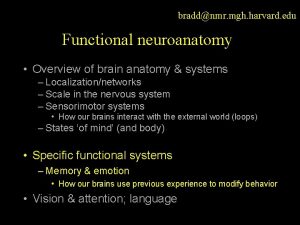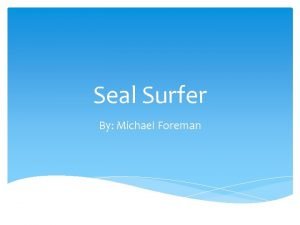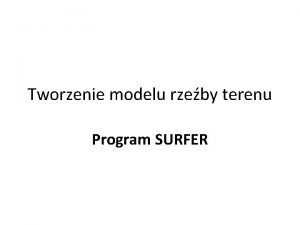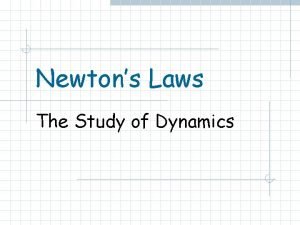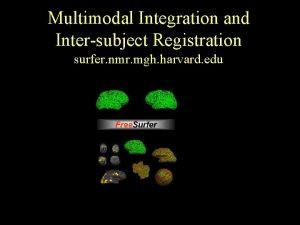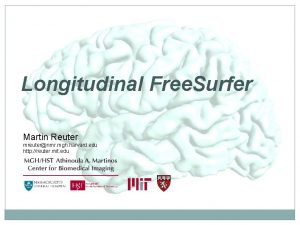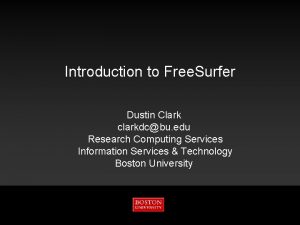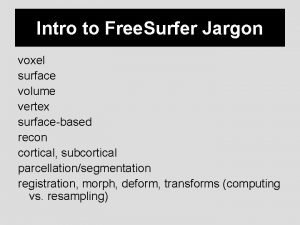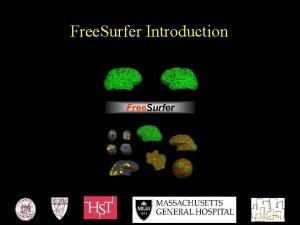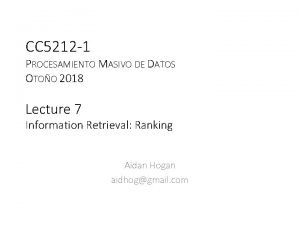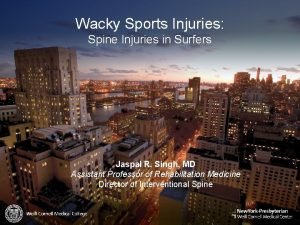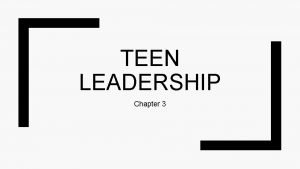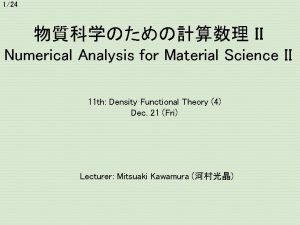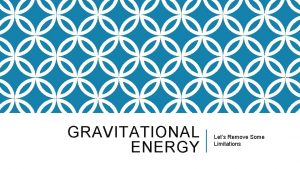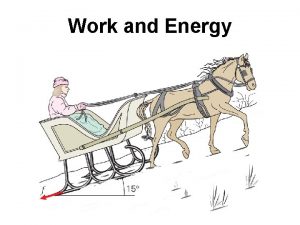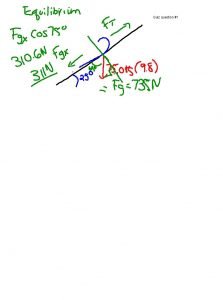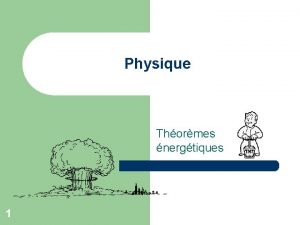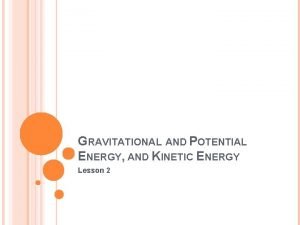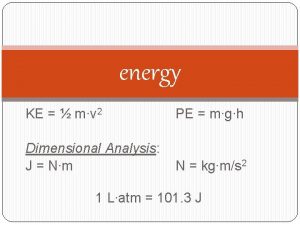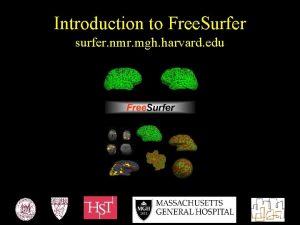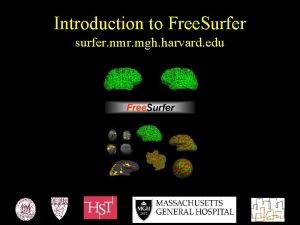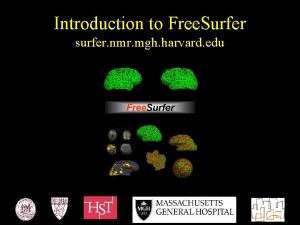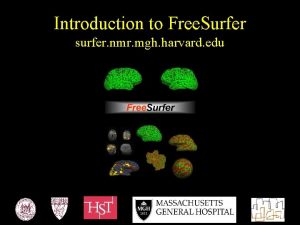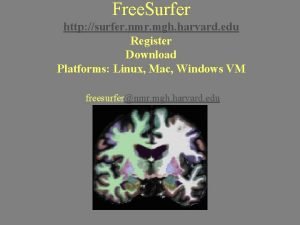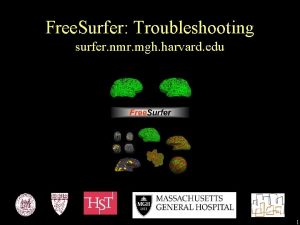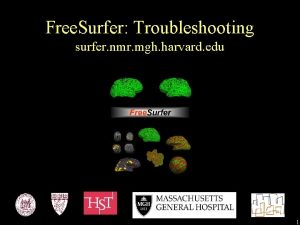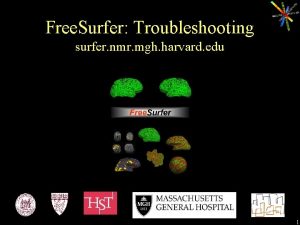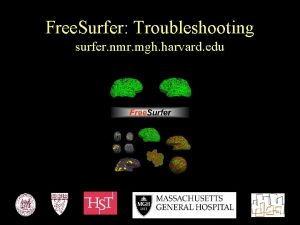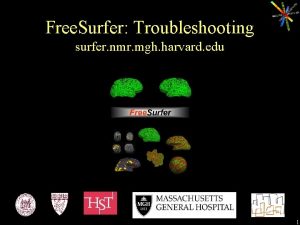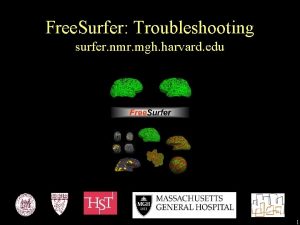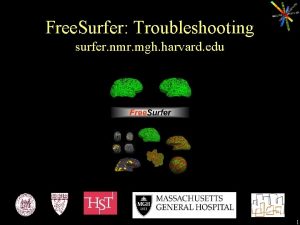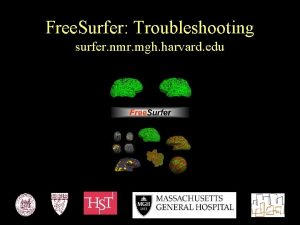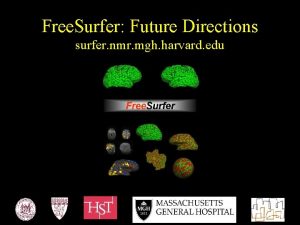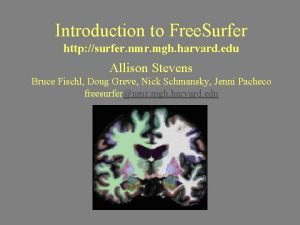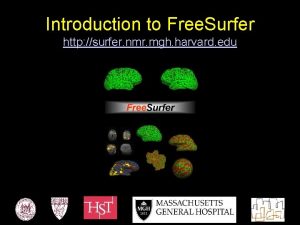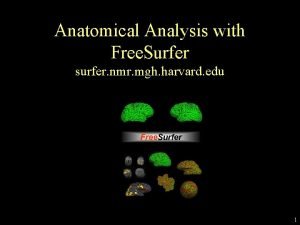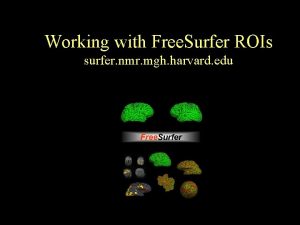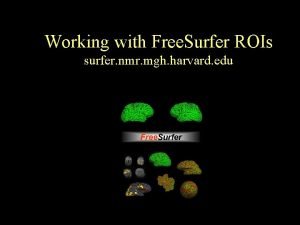Introduction to Free Surfer surfer nmr mgh harvard





























- Slides: 29

Introduction to Free. Surfer surfer. nmr. mgh. harvard. edu

Post Your Questions! http: //surfer. nmr. mgh. harvard. edu/cgi-bin/fsurfer/questions. cgi

To Caffeinate or not to Caffeinate? Please don’t spill coffee (or anything else on the laptops), or if you feel you must, please be prepared to fund a replacement!

Why Free. Surfer? 1. Anatomical analysis is not like functional analysis – it is completely stereotyped. 2. Registration to a template (e. g. MNI/Talairach) doesn’t account for individual anatomy. 3. Even if you don’t care about the anatomy, anatomical models allow functional analysis not otherwise possible.

Why not just register to an ROI Atlas? 12 DOF (Affine) ICBM Atlas

Problems with Affine (12 DOF) Registration (you will get sick of this slide) Subject 1 Subject 2 aligned with Subject 1 (Subject 1’s Surface)

Surface and Volume Analysis Cortical Reconstruction and Automatic Labeling Surface Flattening Inflation and Functional Mapping Surface-based Intersubject Alignment and Statistics Automatic Subcortical Gray Matter Labeling Automatic Gyral White Matter Labeling

Talk Outline 1. Cortical (surface-based) Analysis. 2. Volume Analysis.

Talk Outline 1. Cortical (surface-based) Analysis. 2. Volume Analysis.

Flat Map of Monkey Visual Areas D. J. Felleman and D. C. Van Essen, CC, 1991

Why Is a Model of the Cortical Surface Useful? Local functional organization of cortex is largely 2 dimensional! Eg, functional mapping of primary visual areas: From (Sereno et al, 1995, Science). Also, smooth along surface

Surfaces: White and Pial

Inflation

Surface Flattening – Whole Hemisphere central anterior sylvian Inflated surface with cuts posterior superior temporal Metrically optimal flat map calcarine

Cortical Thickness • Distance between white and pial surfaces • One value per vertex white/gray surface lh. thickness, rh. thickness pial surface

A Surface-Based Coordinate System

Comparing Coordinate Systems and Brodmann Areas Cumulative histogram (red=surface, blue=nonlinear Talairach) Ratio of surface accuracy to volume accuracy

Automatic Surface Segmentation Precentral Gyrus Superior Temporal Gyrus Postcentral Gyrus Based on individual’s folding pattern

Inter-Subject Averaging Spherical Subject 1 Native GLM Spherical Subject 2 Demographics Surface-to. Surface mri_glmfit cf. Talairach Surface-to. Surface

Visualization Borrowed from (Halgren et al. , 1999)

Rosas et al. , 2002 Sailer et al. , 2003 Kuperberg et al. , 2003 Fischl et al. , 2000 Gold et al. , 2005 Salat et al. , 2004 Rauch et al. , 2004

Talk Outline 1. Cortical (surface-based) Analysis. 2. Volume Analysis.

Volume Analysis: Automatic Individualized Segmentation Surface-based coordinate system/registration appropriate for cortex but not for thalamus, ventricular system, basal ganglia, etc… Anatomy is extremely variable – measuring the variance and accounting for it is critical (more in the individual subject talk)!

Volumetric Segmentation (aseg) Cortex White Matter Lateral Ventricle Thalamus Caudate Pallidum Hippocampus Not Shown: Nucleus Accumbens Cerebellum Putamen Amygdala

Volume Differences Predictive of AD Data courtesy of Drs Marilyn Albert and Ron Killiany

Combined Segmentation aparc+aseg

Gyral White Matter Segmentation + aparc+aseg + wmparc Nearest Cortical Label to point in White Matter aparc

Summary • Why Surface-based Analysis? – – Function has surface-based organization Visualization: Inflation/Flattening Cortical Morphometric Measures Inter-subject registration • Automatically generated ROI tuned to each subject individually Use Free. Surfer Be Happy

Acknowledgements MGH MIT Allison Stevens Nick Schmansky Andre van der Kouwe Doug Greve David Salat Evelina Busa Lilla Zollei Koen Van Leemput Sita Kakunoori Ruopeng Wang Rudolph Pienaar Krish Subramaniam Diana Rosas Jean Augustinack Polina Golland B. T. Thomas Yeo Mert Sabuncu Florent Segonne Peng Yu Ramesh Sridharan Martin Reuter Anastasia Yendiki MGH (past) Brian T Quinn Xiao Han Niranjini Rajendran Jenni Pacheco Sylvester Czanner Gheorghe Postelnicu Sean Marrett Kevin Teich NINDS UC San Diego Anders Dale UCL Marty Sereno
 Mgh.harvard.edu
Mgh.harvard.edu Free surfer
Free surfer Ride the waves
Ride the waves Program surfer
Program surfer Normal force
Normal force Surfer
Surfer Surfer
Surfer Surfer
Surfer Free
Free Tksurfer
Tksurfer Surfer
Surfer Surfer
Surfer Random surfer model
Random surfer model Surfer myelopathy
Surfer myelopathy Interpersonal skills in soul surfer
Interpersonal skills in soul surfer Fermisurfer
Fermisurfer Fermi surfer
Fermi surfer Magánhangzótörvények
Magánhangzótörvények Eg = mgh
Eg = mgh Gpe =mgh
Gpe =mgh Gpe mgh
Gpe mgh Si unit of work
Si unit of work Epg = m.g.h
Epg = m.g.h Mgh haven
Mgh haven Eric rosenberg mgh
Eric rosenberg mgh Bacterial vaginosis under microscope
Bacterial vaginosis under microscope La carga de un ascensor tiene una masa total de 2800 kg
La carga de un ascensor tiene una masa total de 2800 kg Thormes
Thormes Eg=mgh
Eg=mgh P.e=mgh dimensions
P.e=mgh dimensions
